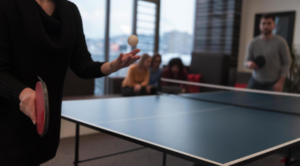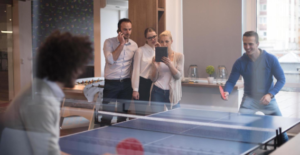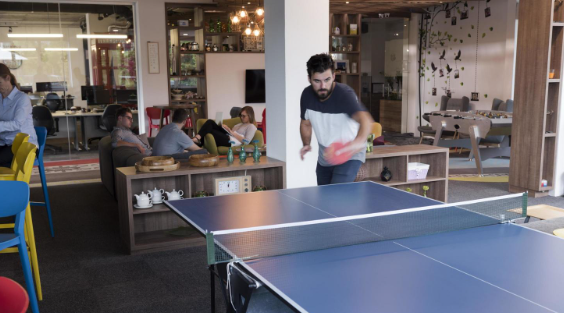Tennis rules hit ball before bounce
Table tennis, on a regular basis called ping pong, is a fast-moving sport that calls on precision, skill, and a strong knowledge of its rules to win. One of the essential components of gambling competitively is the rule of thumb concerning when gamers are allowed to strike the ball and when the player’s of Table Tennis rules hit the ball before bounce.
In this newsletter, we are able to explore the Table Tennis rules hit ball before bounce on their aspect of the desk. This discussion will now not only cover the significance of this rule however additionally delve into techniques and suggestions to beautify your gameplay.
Knowing the Rule: Hitting the Ball Before It Bounces
Definition of the Rule
In professional table tennis, players are permitted to hit the ball more quickly than it appears on their side of the table. This rule can be crucial for keeping an aggressive fashion of play. By flinging the ball in high above the ground, gamers can most likely catch their opposing team off to defend and continue to maintain control of the game.
- Forceful Stroke: Striking the ball before it has a chance to bounce gives players control over the tempo of the match.
- Control: This improves a players’ ability to place the ball, making it harder for the opponent to play a return.
- Quick Reflexes: To execute this maneuver successfully requires fast reflexes and timing.

Importance of Timing
Timing is extremely important when it comes to striking the ball before it bounces. Players must earn a keen sense of when to execute a move to maximize their performance. Practicing this skill can significantly improve a player’s overall performance and confidence during matches.
- Skill Development: Regular practice helps players refine their timing and improve their overall technique.
- Game Awareness: Understanding the right moments to hit the ball can lead to better decision-making in matches.
- Pressure Handling: Players learn to manage pressure situations by becoming accustomed to striking the ball quickly.
Advantages of Hitting Before Bounce
Gaining an Advantage
The main benefit of attacking the ball before a bounce is the ability to put your opponent on the back foot. This technique is especially effective against players who are good at defense. Players can break their opponent’s rhythm by hitting the ball while in the air.
- Secret Element: Opponents may not plan for a midair shot, giving the chasing player a shrewd edge.
- Increased Pace: A quick strike can force opponents into making mistakes or rushed returns.
- Pressure Creation: Hitting the ball before it bounces creates immediate pressure, keeping opponents on their toes.
Teaching Skills
Learning how to hit the ball before it bounces takes time and practice. The hand eye coordination, footwork, the timing needed to hit a ball, it all requires years of practice. The rule forces players to be faster and more reactive.
- Eye-Hand Coordination: Gamers can improve their skills in measuring how far to hit the ball, and when it is to be hit.
- Footwork: You need good footwork to be in position to hit the ball.
- Targeted Practice: Specific drills can help the ability to execute this skill on a regular basis.
Strategies for Hitting Before Bounce
Practicing the Technique
The drills to hit the ball before it bounces should form part of the player training. Regular Practice will create muscle memory.
- Shadow Practice: Mimicking the motion without the ball helps players develop their stroke technique.
- Partner Drills: Practicing with a partner allows for real-time feedback and adjustments.
- Video Analysis: Recording practice sessions can help players identify areas for improvement.

Tuning in to Opponent’s Play style
Especially in competitive table tennis, adapting to your opponent’s play style is very important. Knowing when to catch a midair ball can change the face of a game. Players will have to keep an eye out and play accordingly.
- Observing Patterns: Identifying an opponent’s tendencies can inform decisions about when to hit early.
- Setting Traps: Players can set up specific scenarios to lure opponents into making mistakes.
- Reading the Game: Good players develop a sense for predicting their opponent’s next move.
Rules and Regulations
Official Guidelines
The International Table Tennis Federation (ITTF) makes the following stipulations on when and how players can make contact with Table Tennis rules hit ball before bounce. Competitive players must understand these regulations to avoid penalties.
- Legal Strike: The ball must be hit on the player’s side before it crosses over to their opponent’s side.
- Violations and Punishments: Not following this rule, it will be a fault to lose a point.
- Service Rules: During the service, the same principles apply, and the ball must also be hit before it bounces on the server’s half.
Importance of Fair Play
Adhering to the rules is vital for maintaining fairness in competition. Players who follow the regulations contribute to a respectful and professional environment. Understanding and applying the rule of hitting before the bounce is part of this commitment.
- Respecting Opponents: Fair play fosters respect among competitors.
- Game Integrity: Adhering to the rules ensures the game remains competitive and enjoyable.
- Role Models: Players who demonstrate fair play set an example for newcomers to the sport.
Enhancing Your Game with Early Hits
Building Confidence
Regularly practicing hitting the ball before it bounces can boost a player’s confidence. As players become more adept at this technique, they will feel more empowered during matches, leading to a more assertive playing style.
- Positive Reinforcement: Successfully executing early hits encourages players to keep trying.
- Mental Fortitude: Confidence gained through practice translates into better performance under pressure.
- Enjoyment of the Game: A confident player is more likely to enjoy the game and its challenges.
Combining Techniques
Adding the tactic of hitting the ball before it has the chance to bounce with other tactics will lead to a more diverse approach to the game. Players can mix up offense and defense to keep enemies on their toes.

- Mixing Up Shots: Combining early hits with varying shot types keeps opponents off balance.
- Deception: Players can use feints to confuse their opponents, making it harder for them to anticipate the next shot.
- Overall Game Strategy: Developing a comprehensive strategy that includes early hits can enhance overall performance.
Conclusion
Table Tennis rules hit ball before bounce, To sum up, knowing the competitive table tennis rule about hitting the ball with or without bouncing can be the first step towards making an ascent in the game. Not only does this make for an interesting layer of gameplay, it has players working on skills such as timing, coordination and adaptability. With continued practice and assimilation in their larger framework, players will elevate their competitive spirit and savor the sport to its fullest.
So as you go on fine-tuning the science of table tennis, bear in mind that practicing getting the ball before it bounces is an art that gets consummated only with time. And whether you’re just starting out or have been playing for years, pursuing this rule will make your playing experience more engaging and enjoyable. Now, go grab a paddle, head to the practice table, and make those shots airborne right this very minute!








2 thoughts on “The Competitive Table Tennis rules hit ball before bounce”